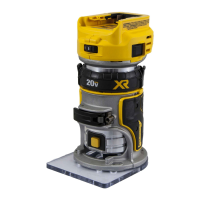14
ENGLISH
3. Lock the plunge mechanism by releasing the plunge lock
lever
16
4. Position the router on the cutting line. The outer cutting
edge of the cutter must coincide with the cuttingline.
5. Slide the parallel fence
39
against the workpiece and
tighten the thumb screws
37
.
Attaching a Dust Extraction System to the
Fixed Base (Fig.I)
To connect the router to a dust extraction system for dust
collection, follow these steps:
1. Remove the motor unit from the base. Refer to Removing
the Motor from the FixedBase.
2. Attach dust extraction system attachment accessory
29
to the base as shown. Tighten thumb screws
30
securely
byhand.
3. Attach hose adapter to dust extraction system
attachmentaccessory.
4. When using dust extraction system attachment, be aware
of the placement of the dust extraction system. Be sure that
the dust extraction system is stable and that its hose will not
interfere with thework.
Attaching a Dust Extraction System to the
Plunge Base, DCW604 Only (Fig.J)
1. Remove the motor unit from the base. Refer to Removing
the Motor from the PlungeBase.
2. Slide tab
31
(inset) on dust extraction system
attachment
35
into slot in plunge base and snap tab
32
(inset) into hole in plungebase.
3. Secure to base with supplied plastic washer
33
and thumb
screw
34
. Tighten thumb screw securely byhand.
4. Attach hose adaptor to dust extraction systemattachment.
When using dust extraction system attachment, be aware of
the placement of the dust extraction system. Be sure the dust
extraction system is stable and its hose will not interfere with
thework.
Set-Up: Fixed Base (Fig.A,K, L)
Inserting the Motor into the Fixed Base
1. Open the locking lever
12
on thebase.
2. If the depth adjustment ring
5
is not on the motor
6
,
thread the depth adjustment ring onto the motor until the
ring is about halfway between the top and bottom of the
motor as shown. Insert the motor into the base by aligning
the groove on the motor
6
with the guide pins
17
on the
base. Slide the motor down until the depth adjustment ring
snaps intoplace.
NOTE: Guide pin grooves
9
are located on either side of
the motor so it can be positioned in twoorientations.
3. Adjust the depth of cut by turning the depth adjustment
ring. Refer to Adjusting the Depth ofCut.
4. Close the locking lever
12
when the desired depth is
achieved. For information on setting the cutting depth, refer
to Adjusting the Depth ofCut.
Adjusting the Depth of Cut (Fig.L)
1. Open the locking lever
12
and turn the depth adjustment
ring
5
until the bit just touches the work piece. Turning
the ring clockwise raises the cutting head while turning it
anticlockwise lowers the cuttinghead.
2. Turn the micro-adjustment scale
11
clockwise until the 0
on the scale lines up with the pointer on the bottom of the
depth adjustmentring.
3. Turn the depth adjustment ring until the pointer lines up
with desired depth of cut marking on the micro-adjustment
scale
11
.
NOTE: Each mark on the adjustment scale represents a
depth change of 0.4 mm and one full (360º) turn of the ring
changes the depth 12.7mm.
4. Close the locking lever
12
to lock thebase.
Removing the Motor from the Fixed Base (Fig.K)
1. Remove the battery pack from the motor. Refer to Inserting
and Removing the BatteryPack from the Tool.
2. Open the locking lever
12
on thebase.
3. Grasp the motor unit with one hand, depressing both quick
release tabs
45
.
4. With the other hand, grasp the base and pull motor from
thebase.
Set-Up: Plunge Base, DCW604 Only
(Fig.A,M)
Inserting the Motor into the Plunge Base
1. Remove the depth adjustment ring
5
from the motor
6
. It
is not used with the plungebase.
NOTE:Snap depth adjustment ring onto fixed base, when
not in use, to preventloss.
2. Open the plunge base locking lever
40
.
3. Making sure the spindle lock button is facing front, insert the
motor
6
into the base by aligning the groove on the motor
with the guide pins
17
on the base. Slide the motor down
until the motor stops on the motor stop
19
.
4. Close the locking lever
40
.
Adjusting the Plunge Routing Depth (Fig.M)
WARNING: Laceration hazard. Do not change the
turret stop while the router is running. This will place
your hands too near the cutterhead.
WARNING: To prevent loss of control, ALWAYS
tighten the travel-limiting nuts together. Inadvertent
movement could prevent full bitretraction.
WARNING: To prevent loss of control, set the travel-
limiting nuts so that bit can be retracted into the
base of the router, clear of theworkpiece.
WARNING: To reduce the risk of injury, NEVER adjust
or remove the stop nut. Motor can disengage resulting
in loss ofcontrol.

